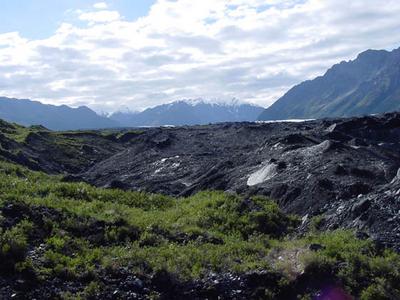30 July, 2002
A hike in the woods........
Today I helped out Tim Alessi, the REU student from the University of
Wisconsin at Oshkosh. His project area is in a moraine area to the north of
the terminus of the glacier. The area is covered, for the most part, by
forest. Buried ice still exists beneath the sediments that the vegetation
is growing on. With his project, he is attempting find a correlation
between the age of the forest in this moraine area and the depth of the
sediment over buried ice. This information will then be compared to other
models of glacial karst topography.
He has set up a profile line that runs in a general northward direction for
1400m. It begins near a boundary between non vegetated moraine and moraine
that is vegetated. The profile ends at the Matanuska River where bedrock is
exposed directly at the surface.
I helped Tim collect samples of soil from the area. At 100m intervals
across this profile, we removed a soil sample that will be studied for
information such as depth of the soil, structure and nutrient content. The
soil at all of these sites was very shallow yet in many of the areas there
was relatively mature forest.
At each interval we also collected a tree bore sample. This is accomplished
by using a device that drills a small hole into the tree, but leaves behind
a core in the middle of the drill hole that can be removed. By counting the
rings of the sample an age for the tree can be determined. This information
is important because it gives an idea of how long ago conditions were
suitable for tree growth, and an estimate of how long the ice that is
present has been there. At some locations, trees were found that were well
over 100 years old. Thatıs a long time for ice to be melting, so imagine
how massive the buried ice must be!
As the ice melts out from beneath the sediment covering it, the surface
landscape changes. The vegetation that grows on this ever changing
landscape shows these changes in many ways. Today, I saw many examples of
this. There were trees that were split right down the middle, as land on
one side of the tree settled relative to the other side. There were also
areas covered by what is referred to as ³drunken forests². When ice melts
out from beneath the sediment and soil that supports a forest, the trees
lean in many different directions giving the forest an overall ³tipsy²
appearance.
Life Is Good
DT

Looking roughly to the south east from vegetation covered moraine across debris covered ice. If you look very carefully, some clean ice is visible in the distance.

Buried ice beneath sediment supporting quite mature vegetation. This ice was exposed in an area where the sediment on top of the ice is continually sliding down a fairly steep slope.

This tree has split as the ice beneath the sediment has melted out and the surface has settled differently on opposite sides of the tree. This split happened some time ago as the tree showed signs of healing, and is still very much alive.
Contact the TEA in the field at
.
If you cannot connect through your browser, copy the
TEA's e-mail address in the "To:" line of
your favorite e-mail package.
|
